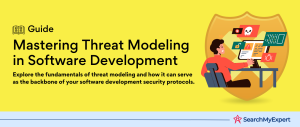What is secure software development?
Secure software development (SSD) is a process of designing, developing, testing, and deploying software that is resistant to attack. SSD involves integrating security into every phase of the software development lifecycle (SDLC), from requirements gathering to deployment and maintenance.
Why is it important?
SSD is important because software vulnerabilities can be exploited by attackers to gain unauthorized access to systems and data, steal information, or launch denial-of-service attacks. SSD can help to reduce the risk of these attacks and protect users and organizations from harm.
The benefits of secure software development
There are many benefits to secure software development, including:
- Reduced risk of data breaches and other security incidents
- Improved customer trust and confidence
- Compliance with industry regulations and standards
- Reduced costs associated with security breaches and remediation
- Improved product quality and reliability
Security Tools
Security tools can help organizations to identify, assess, and mitigate security risks in software. There are a variety of security tools available, each with its own strengths and weaknesses.
Static code analysis tools
Static code analysis tools inspect source code for potential security vulnerabilities. These tools can be used to identify coding errors, common security weaknesses, and compliance violations.
Dynamic application security testing (DAST) tools
DAST tools test running applications for security vulnerabilities. These tools can be used to identify vulnerabilities that are not detectable by static code analysis tools, such as cross-site scripting (XSS) and SQL injection vulnerabilities.
Software composition analysis (SCA) tools
SCA tools scan software applications for known vulnerabilities in open source and third-party components. These tools can help organizations to identify and address vulnerabilities that they may not be aware of.
Interactive application security testing (IAST) tools
IAST tools are a type of dynamic application security testing that instruments running applications to detect and analyze security vulnerabilities. These tools can be used to provide real-time feedback to developers on security risks in their code.
Container security tools
Container security tools help organizations to secure their containerized applications. These tools can be used to scan container images for vulnerabilities, detect and prevent malicious activity in containers, and enforce security policies for containers.
Cloud security tools
Cloud security tools help organizations to secure their cloud-based applications and data. These tools can be used to monitor and protect cloud resources, detect and respond to security incidents, and enforce security policies for cloud environments.
Organizations should choose security tools that are appropriate for their specific needs and environment. They should also consider the following factors when selecting security tools:
- The types of vulnerabilities that the tool can detect
- The accuracy and completeness of the tool’s results
- The ease of use and integration with the development workflow
- The cost of the tool
Security Best Practices
In addition to using security tools, organizations should also follow security best practices to develop and deploy secure software. Some important security best practices include:
Adopt a DevSecOps approach
DevSecOps is a security-first approach to software development that integrates security into every phase of the SDLC. DevSecOps teams collaborate to identify, assess, and mitigate security risks as early as possible in the development process.
Implement a secure software development lifecycle (SDLC) management process
An SDLC management process provides a framework for developing and deploying secure software. The process should include activities such as threat modeling, secure coding, code review, testing, and deployment security.
Address open-source vulnerabilities
Open source components are often used in software development, but they can also introduce security vulnerabilities. Organizations should use SCA tools to identify vulnerabilities in open source components and take steps to mitigate them.
Automate simple security tasks
Many security tasks can be automated, such as vulnerability scanning, penetration testing, and security policy enforcement. Automating these tasks can free up security professionals to focus on more complex tasks and reduce the risk of human error.
Be aware of your own assets
Organizations should have a good understanding of their own assets, including their software applications, data, and systems. This knowledge is essential for identifying and protecting critical assets.
Perform risk assessment
Risk assessment is the process of identifying, assessing, and prioritizing security risks. Organizations should perform risk assessments regularly to identify new risks and changes to existing risks.
Provide security training for developers
Developers play a critical role in secure software development. Organizations should provide security training for developers to help them understand security principles and best practices.
Manage containers properly
Containers introduce new security challenges. Organizations should implement container security best practices, such as using vulnerability scanners, running containers with the least privilege, and isolating containers from each other.
Limit user access to data
Organizations should limit user access to data to only what is necessary. This can be done by implementing role-based access control (RBAC) and other access control mechanisms.
Update and patch regularly
Software vendors regularly release security patches to address vulnerabilities in their software. Organizations should apply security patches promptly to reduce the risk of exploitation.
Ensure access to log data
Log data can be used to detect and investigate security incidents. Organizations should ensure that they have access to log data from all of their systems and applications.
Encrypt your data
Encryption can help to protect data from unauthorized access, even if it is stolen or compromised. Organizations should encrypt all sensitive data, both at rest and in transit.
These are just some of the many security best practices that organizations can follow to develop and deploy secure software. By following these best practices, organizations can reduce the risk of security breaches and protect their users and data.
Conclusion
Secure software development is essential for protecting organizations and their users from security attacks. By following security best practices and using security tools, organizations can develop and deploy software that is resistant to attack.
Ascend beyond the ordinary with Software Development companies driving the future of tech!
Table of Contents
Toggle






